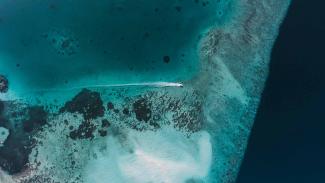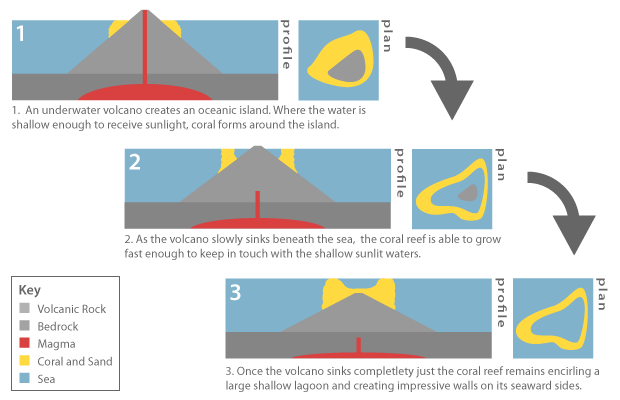The rise of an atoll

Of the many intricate and incredible forms that coral reefs take, atolls are possibly the most majestic. Rising straight out of the deep ocean, these relatively tiny specs of coral attract huge amounts of marine life and make for a spectacular sight, both above and below the water.
But how did these oases in the middle of the ocean appear? What forces created them and why do they attract so much life?
While not known as his most famous discovery, it was actually Darwin who uncovered the secrets of the atolls.
Darwin's atoll
He was puzzled by their odd formation, rising so abruptly out of the seemingly featureless ocean and always protecting a shallow lagoon. Darwin suggested that coral atolls were once part of ancient volcanoes, which are now long submerged below the waves.
His theory proposed that these old volcanoes once rose above the surface of the sea and the coral reefs that we now see were once fringing reefs on its slopes. In time, as with many old mountain chains, the volcano began to sink below the waves. This sinking process, just a few centimetres per year, was slow enough to allow the coral reef to build upon its foundations and stay in touch with the warm, shallow waters near the surface.
As the volcano continued to sink, so the coral continued growing upwards, always remaining just below the surface, but plunging down to ever deeper depths as its foundations sunk with the volcano.
Eventually, the entire volcano sunk below the waves, leaving behind a ring of coral reef surrounding a central, shallow lagoon - the crater of the volcano - and creating the coral atolls we know and love today.
While Darwin's theory has always been widely accepted, more recently scientists have looked to back the theory up with hard evidence. They drilled down in atolls in the Pacific in search of evidence of submerged volcanoes. They found exactly the evidence they were looking for, confirming Darwin's theory to be an almost word perfect account of a coral atolls' history.




